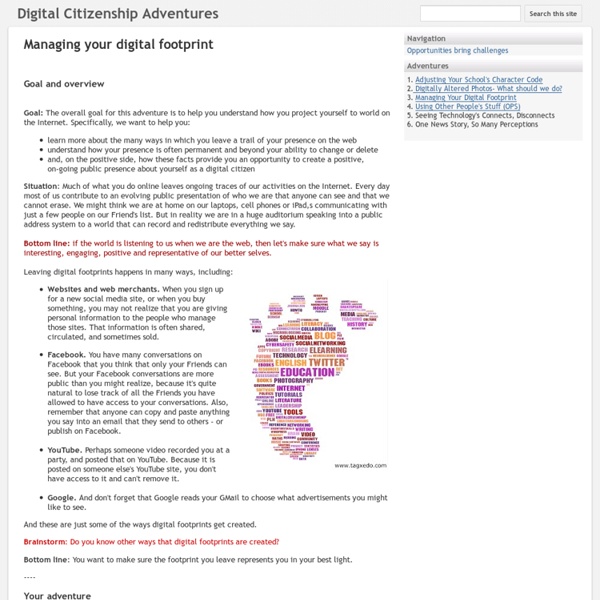Seriously, It's Time To Manage Your Online Reputation [Infographic]
10 Ways To Become A Better Online Learner 9.06K Views 0 Likes There are some quick and easy ways to become a better online learner. Whether you're taking a class or just researching, here are the DOs and DON'Ts. 6 Ways To Start Using Online Quizzes In The Classroom 7.82K Views 0 Likes As a teacher, getting your students excited for test time can be a drag.
Giving Students Ownership of Learning:Footprints in the Digital Age
November 2008 | Volume 66 | Number 3 Giving Students Ownership of Learning Pages 16-19 As the geeky father of a 9-year-old son and an 11-year-old daughter, one of my worst fears as they grow older is that they won't be Googled well. Not that they won't be able to use Google well, mind you, but that when a certain someone (read: admissions officer, employer, potential mate) enters "Tess Richardson" into the search line of the browser, what comes up will be less than impressive. That a quick surf through the top five hits will fail to astound with examples of her creativity, collaborative skills, and change-the-world work. Or, even worse, that no links about her will come up at all. It's a consequence of the new Web 2.0 world that these digital footprints—the online portfolios of who we are, what we do, and by association, what we know—are becoming increasingly woven into the fabric of almost every aspect of our lives. Networking: The New Literacy Transparent and Trackable References
Don't hide your online self when applying for college or career
According to a study by Internet security company AVG, two thirds of HR managers will browse social media profiles of candidates. When it comes to college about 24% of admission officers admit to tracking applicants on various social media sites to check an applicant’s digital footprint, according to a 2011 Kaplan Test Prep survey. Those that snooped typically found something that hindered the applicant’s chances of acceptance, including photos of alcohol and drug abuse, vulgarity, and evidence of a plagiarized admission’s essay.In response to this, it is common to hear students applying for college or a job say before doing so, they plan to take down their online profiles or change their name to something unidentifiable. Innovative educators know this is not the best strategy. Instead our job is to support young people in creating a responsible digital footprint that, rather than hinder, would attract colleges and employers. So, what do you think?
10 Things Your Students Should Know About Their Digital Footprints
Building a digital legacy is an issue I believe doesn’t garner enough attention in our personal and professional lives. In fact, some of the heaviest users of online tools and social media, are our young students, who are growing up as a generation of visual learners and visual attention seekers. This is in fact the Facebook and YouTube generation, and the reality is that many teens are unconcerned about the dangers of sharing personal information online. A highly respected education advocate, Kevin Honeycutt, once asked me if any of us from our generation (GenX and before), had ever made a mistake in puberty. The reality is that our mistakes from puberty are not “Googleable”. With that in mind, I have developed some important facts and opinions that our students should be completely aware of as they live in their digital world, creating digital footprints along the way. If you’re look for ideas to help make yourself or your staff better through... 1.) 3.) 4.) 5.) 6.) 7.) 8.) 9.) 10.)
Definition Of Digital Citzenship
The Definition Of Digital Citizenship by Terry Heick As more and more students interact digitally–with content, one another, and various communities–the concept of digital citizenship becomes increasingly important. Which begs the question: what is digital citizenship? Well, first citizenship, which is formally defined as “the quality of an individual’s response to membership in a community.” So digital citizenship is nearly the same thing–“the quality of a response to membership in a digital community” would be a good first crack at the definition. Revising that might more clearly articulate the differences between physical and digital communities, so a decent definition of digital citizenship then might be “Self-monitored participation that reflects conscious interdependence with all (visible and less visible) community members” Still too wordy? This makes it useful not just as a visual for teacher understanding, but for students to discuss, internalize, and apply themselves.



